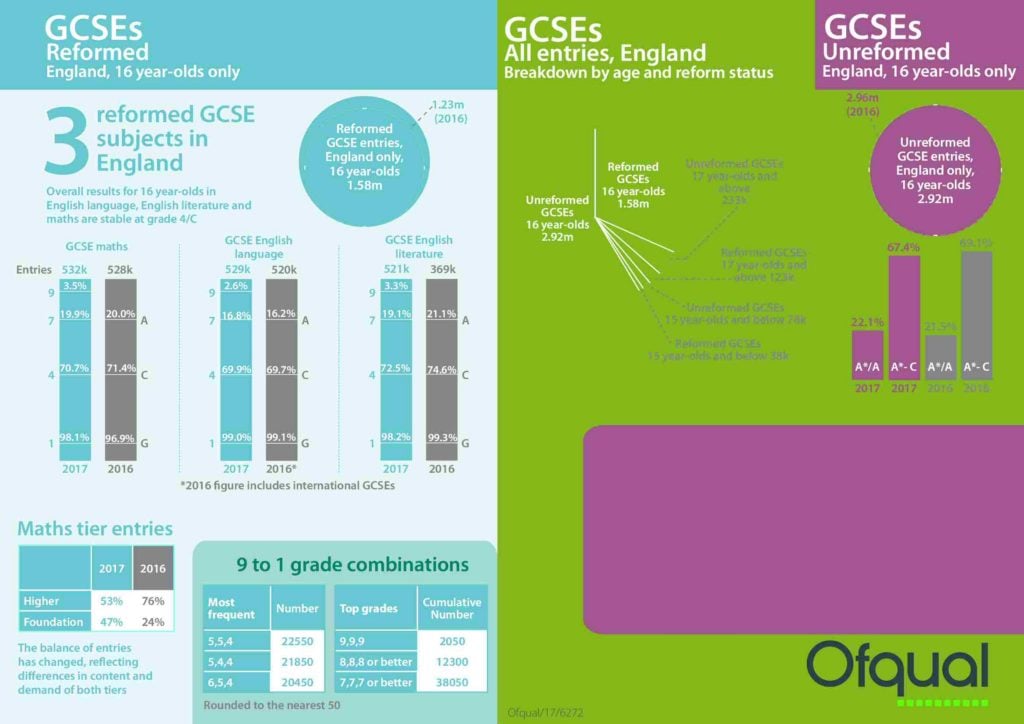Math’scool Students who have reported results back to us:
Number of students who sat the exam: 16
Number who scored Level 9 (A**): 13
Number who scored Level 8 (A*): 3
Number who scored Level 7 or below: None
The results are out and the biggest change in the GCSE examination system for generation is now well underway. It was a pretty messy changeover; the first set of specimen question provided by exam boards suggested it was going to be an exceptionally tough exam, and that created much anxiety for teachers and pupils alike. The second set of specimen materials were much, much less challenging, which only added to the confusion. In the end, the actual papers were somewhere in between, with a good mix of standard GCSE questions of the type that would have been found in pretty much paper over the last 2 decades, and a few questions that really challenged students to be creative in applying the relevant mathematics in unfamiliar situations.
The new papers are designed so that half of the questions (in terms of marks available) would be aimed at the A*/A grade students. So that’s a step change in the proportion of ‘tough’ questions in the papers…
The new grading system committed to award levels 9, font color=”#2B83C3″>8 and 7 to the same proportion of the cohort that received an A* or A grades in the old system. The top 1/5th of those would then be awarded level 9 and the level 8 boundary being equally spaced between the level 9 and the level 7 boundaries.
As it turned out, in maths, the top 3.5% of the cohort were awarded a level 9, the next 6.5% got a level 8 and the 9.3% below those scored level 7.
This concurs with the maths results for 2016 (A*=7.0% , A=12.7%), and the intention to anchor the proportion of levels 9, 8 and 7 (i.e. 19.3%) to the proportion that scored A*/A (i.e. 19.7%) in the previous year. The other intention (that level 9 would be awarded to the top 1/5th of those scoring level 7 or above) was also roughly met. 1/5th of 19.3% that scored level 7 or above yields an expectation that the top 3.86% of candidates would achieve the top ‘level 9’ – and the actual proportion that did (3.5%) is pretty close to that.
There are a couple of nice infographics from Ofqual that demonstate this (although the numbers they use are very slightly different – which is strange because my numbers are from Ofqual’s own documents)
What is not mentioned in all of this is that, while the percentage scoring levels 9, 8 or 7 have been matched to the percentage scoring A*/A under the old system – the actual students that occupy the levels 9, 8 and 7 will be different from those who scored A*/A under the old system.
Why? Well, simply because the demands are different. For instance, if you took a group of 100 young athletes and, to decide which would be chosen represent Britain in an friendly competition, you told them all to run 200m and you picked the fastest 10, you’d get a different group than if, instead, you’d told them all to run 200m hurdles and picked the fastest 10 of those…
So it is with the new GCSE maths: The new papers contained a lot more tricky questions – which means that marks will be lower overall (so therefore, the percentages at the various levels have been maintained by reducing grade boundaries), so to achieve a level 9, a student needs to score 79% in the exam; to achieve a level 7, the score required is just 52%!
Whereas the old paper favoured a student who could answer pretty much all the questions and make very few mistakes in the process, the new paper favours those students who can apply the relevant maths in a flexible way, adapting their approach to tackle questions that are presented in an unusual form. It’s no longer all about answering familiar questions and being meticulous; now students need to develop strong problem solving skills to cope with unfamiliar situations.

At Math’scool, we’ve always seen our GCSE course as a primer for A-level maths and we have always included lots of challenging questions in our courses. Looking at our results for this academic year, this new exam format plays to our strengths – 81% of our students scored A**. The chance that a random sample of GCSE maths students would get that many level 9 scores is less than 1 in a million! Well done kids.
